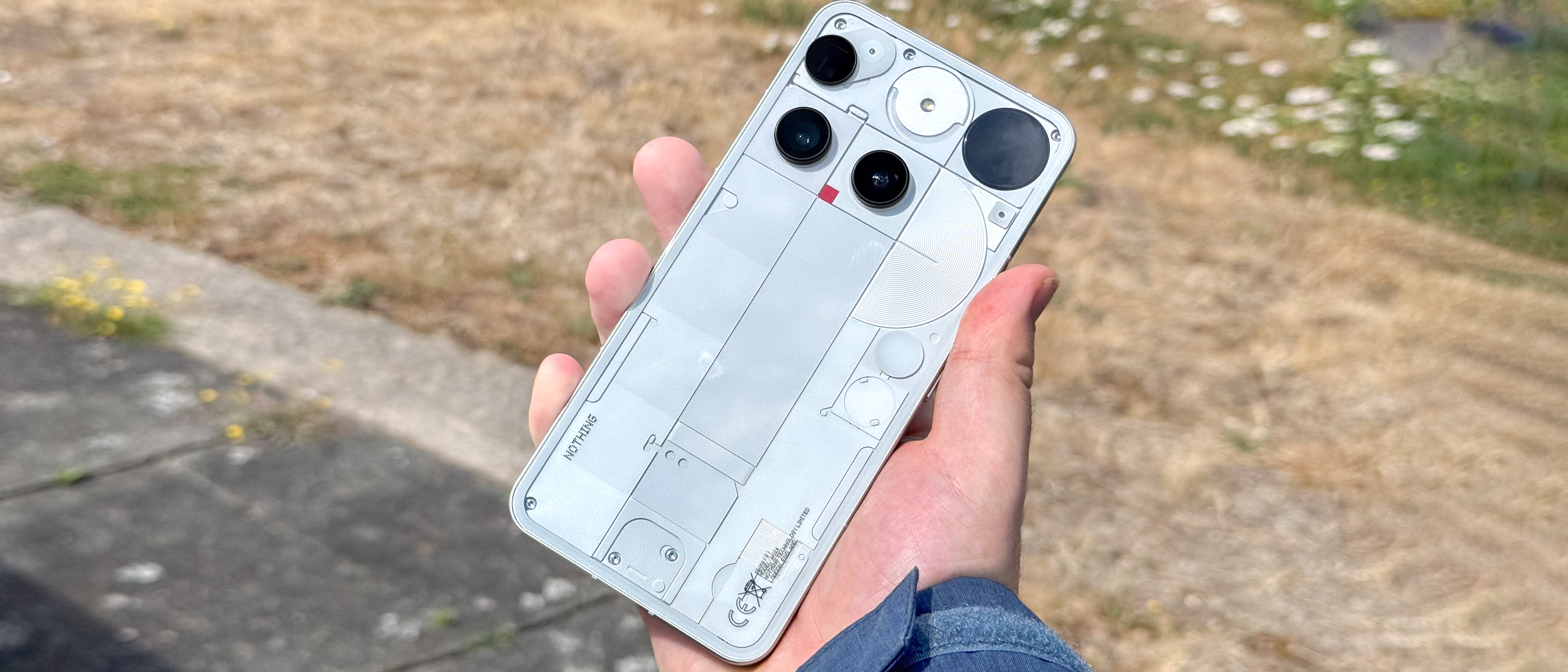Tom's Guide Verdict
A lot has changed since the Nothing Phone 2, but the new Nothing Phone 3 still retains the company's trademark off-kilter take on mobile tech. It's more expensive than previous Nothing phones, but in return, a lot's been upgraded inside and out. If there had been more improvements, the Phone 3 would stand proudly alongside Samsung, Google, and others, but it's still falls a little short, meaning a buying decision requires a balance of head and heart just like before.
Pros
- +
Distinct design with improved durability
- +
New telephoto camera with macro mode
- +
Glyph Matrix both fun and practical
- +
Snapdragon 8S Gen 4 chip offers strong performance
- +
Larger battery and faster charging
Cons
- -
Most expensive Nothing Phone yet
- -
Weak photography overall
Why you can trust Tom's Guide
Nothing has dubbed the Phone 3 its first flagship, which has changed out a lot of what we knew of these unusual devices, but without losing its identity in the process.
While it's priced the same as a Samsung Galaxy S25 or Google Pixel 9, the specs, design and most importantly attitude, diverge drastically, as has been the case with all of Nothing's products. It's a worthy successor to the Nothing Phone 2, even if it cost an extra $200. But at least with the new “Glyph Matrix,” telephoto camera and chipset, you can see where the money is going.
People wanting the best experience in a phone for their money need not apply, but anyone wanting something more interesting in their pocket should absolutely check out the Phone 3. And if you’re not sure yet which of those types of person you are, let me be your guide and help you figure that out.
Nothing Phone 3: Specs
| Row 0 - Cell 0 | Nothing Phone 3 |
Starting price | $799/£799 |
Display | 6.67-inch AMOLED (1260 x 2800) |
Refresh rate | 120Hz adaptive |
Rear cameras | 50MP main (f/1.68), 50MP ultrawide (f/2.2), 50MP 3x telephoto (f/2.68 |
Front cameras | 50MP selfie (f/2.2) |
Chipset | Snapdragon 8S Gen 4 |
RAM | 12GB/16GB |
Storage | 256GB/512GB |
Battery | 5,150 mAh |
Charging | 65W wired, 15W wireless |
Operating system | Android 15 with Nothing OS 3.5 |
Water/dust resistance | IP68 |
Size | 6.32 x 2.98 x 0.35 inches (160.6 x 75.59 x 8.99 mm) |
Weight | 7.69 ounces (218 grams) |
Colors | White, Black |
Nothing Phone 3: Price and availability
Pre-orders for the Nothing Phone 3 are already available, with the official on-sale slated for July 15th. Dedicated fans may be able to find a Phone 3 available at select locations from the 12th, at one of Nothing's early drop events.
However you so choose to get the Nothing Phone 3, it will cost £799 / $799 for the basic model with 12GB RAM and 256GB storage. Doubling the storage to 512GB, and upping the RAM to 16GB, will cost you £899 / $899 instead.
Taking the base price, the Nothing Phone 3 costs the same as a Galaxy S25 or Pixel 9. But both of these phones start with 128GB storage instead, and have quite different specs from the Nothing Phone 3, making a direct comparison tricky to make in place.
Nothing Phone 3: Design and display
Coming in either Black or White, there's no mistaking the Nothing Phone 3 for a phone from any other brand. There's a new three-column grid design that is a break from the circles and ovals that defined all previous Nothing handsets, but with the transparent back panel, exposed screws and as many greebles as the sides of a starship, this is still familiarly different and recognizeably Nothing.
Get instant access to breaking news, the hottest reviews, great deals and helpful tips.
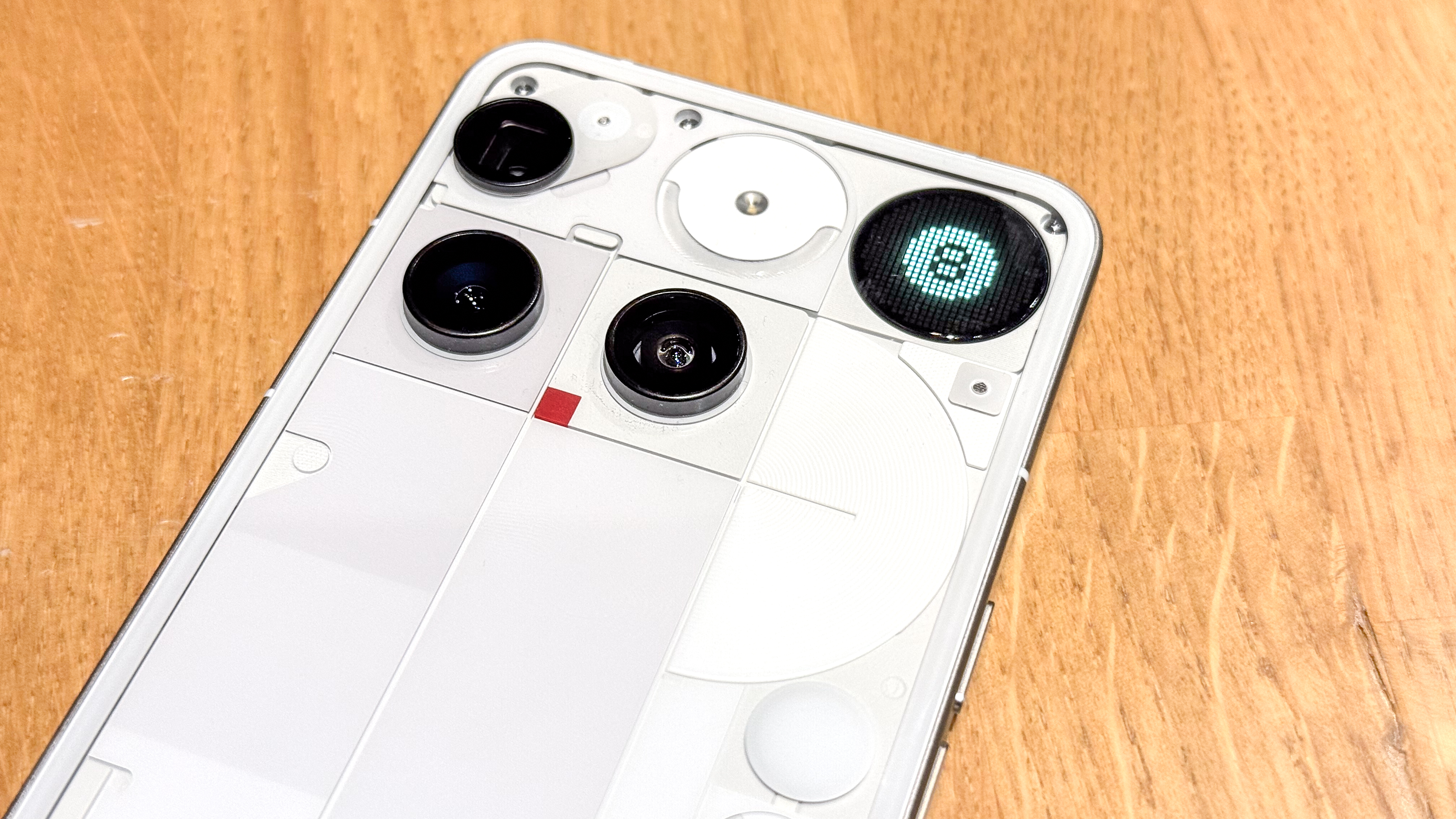
Previous Nothing Phones were built around the Glyph Interface — a series of lights that would pulse, flash and glow to alert you to various notifications, with impressive levels of customizability. This time though, Nothing has elected to replace all that with the Glyph Matrix. This is a much smaller system, sitting in a little black circle in the top right corner of the phone, rather than spanning the whole back panel. But with a grid of 489 pixels, the Glyph Matrix can display much more than the lights ever could, with a series of widgets available via a tap on the concealed button midway down the back of the phone.
These changes in the Nothing Phone 3's design have included upgrades to its durability compared to the Phone 2. The Phone 3 is now rated the gold water/dust resistance standard of IP68 (up from IP54), and now features a Gorilla Glass 7i display and Gorilla Glass Victus on the back. Many flagships use newer versions of GG Vitus, if not the latest Gorilla Glass Armor glass, but it's still an improvement from the Gorilla Glass 5 found on the Phone 2.
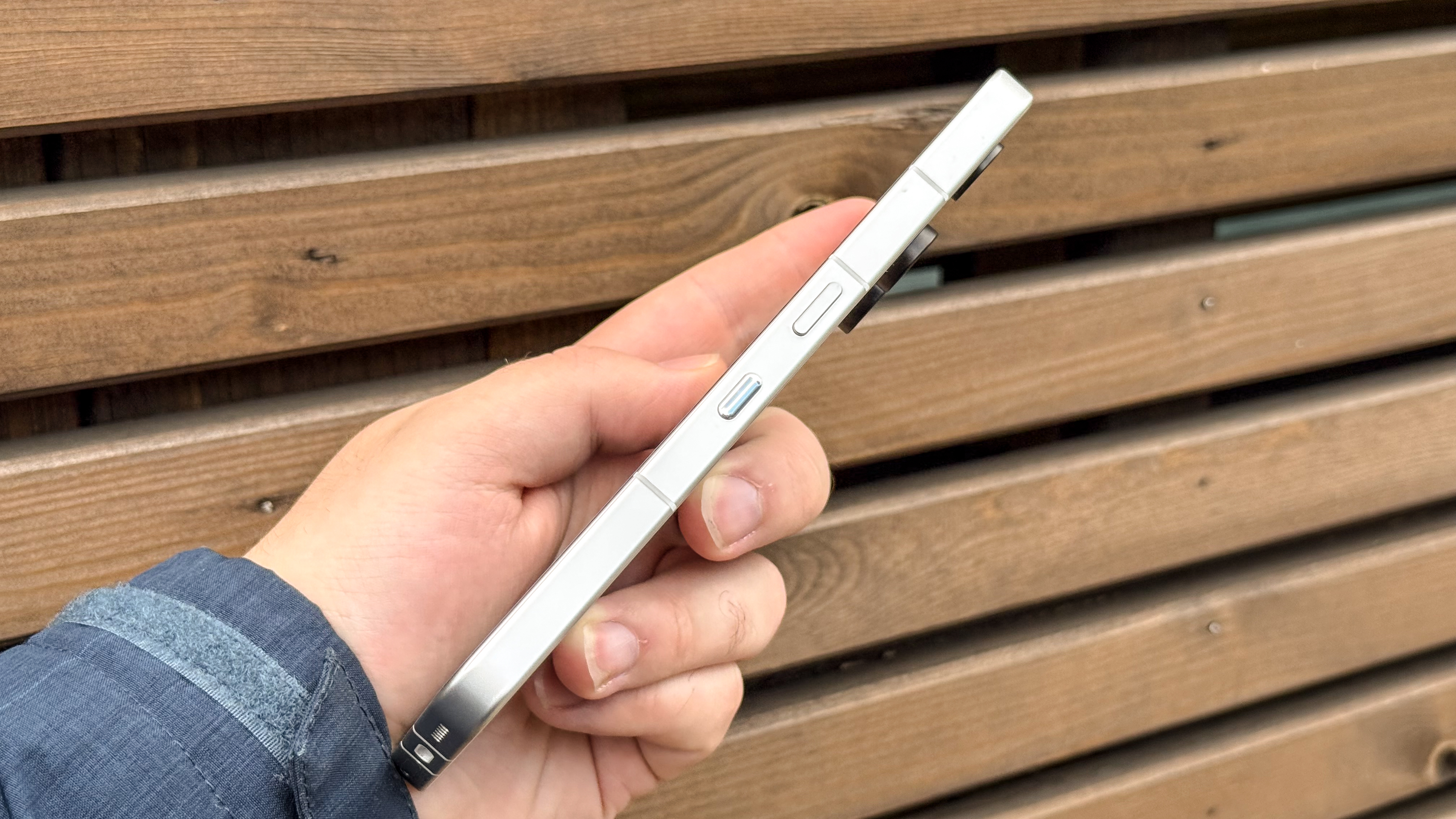
The redesign extends to the Phone 3's display, which has shrunk a little to 6.67 inches rather than the Phone 2's 6.7 inches. But everything else is bigger and better, with a higher resolution, higher brightness ratings and more responsive touch sampling to help with touchscreen gaming, plus the same 120Hz adaptive refresh rate.
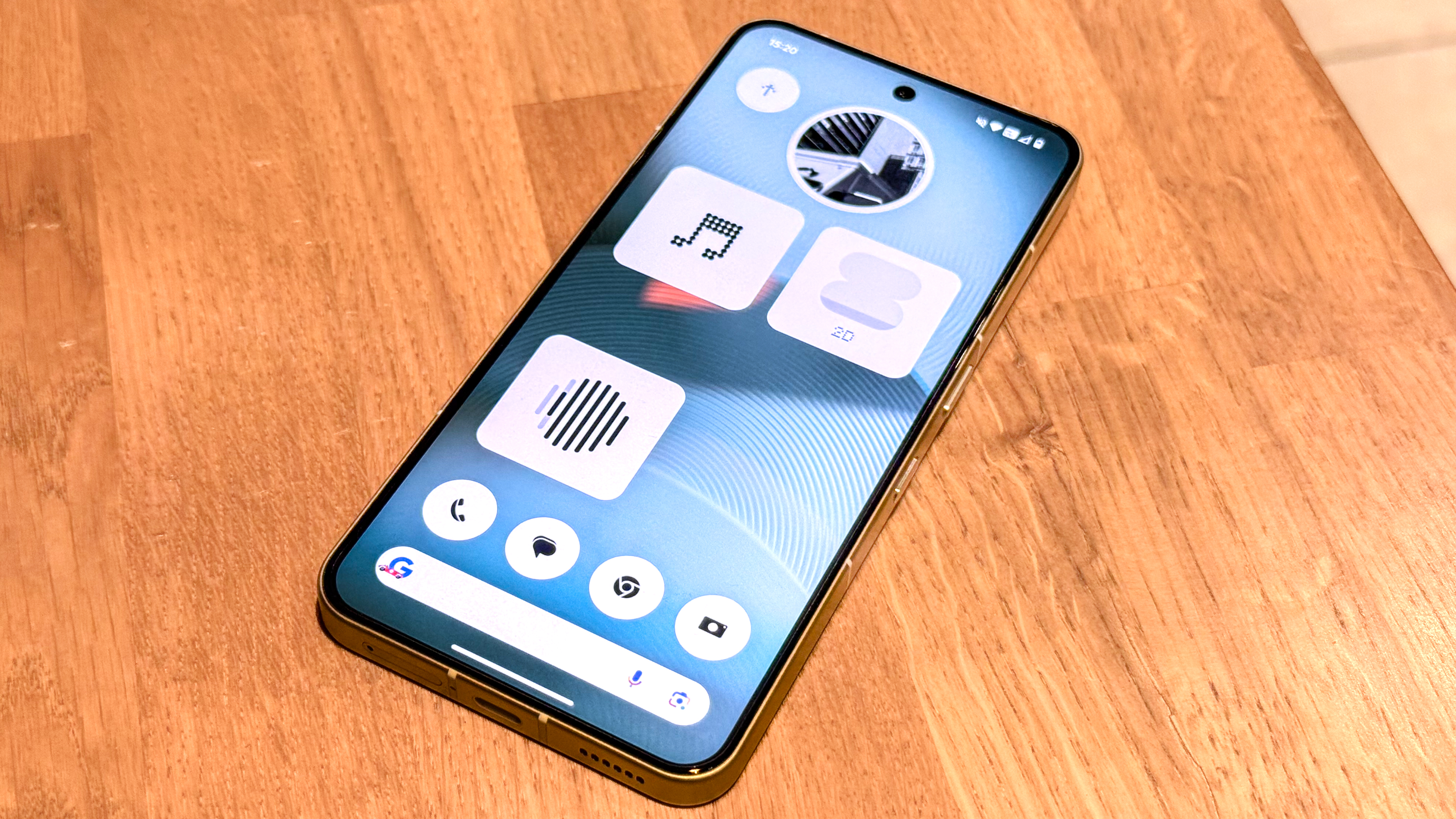
Compared to the Google Pixel 9 Pro XL, the Phone 3 is noticeably dimmer, but that's not surprising considering the latest Pixel's eye-searing Super Actua display tech outshines all other smartphones we've tested. The Galaxy S25 Ultra's anti-reflective display helps with readability in bright light, and still gets brighter than the Nothing Phone 3, but to a lesser extent.
Nothing Phone 3: Cameras
The Nothing Phone 2 already had 50MP main and ultrawide cameras, but now the Phone 3 has added a third 50MP camera to the back, a 3x telephoto one at that. Plus the front camera is also a 50MP sensor, allowing for a strong balance between detail and image brightness.
That's the theory anyway, but as our comparisons will show, photography remains a weak area for Nothing's flagship phones.
I took this main camera shot of Beckenham Green on both the Samsung Galaxy S25 Ultra and the Google Pixel 9 Pro XL as well as the Nothing Phone 3, and found the Nothing matched more closely with the Pixel's image processing style. That said, the Pixel's image is the richer of the two, with the Nothing Phone 3 prioritizing brightness instead.
In this ultrawide of Paddington Station's Paddington statue, the Nothing Phone 3 reproduces a decent amount of color from the sculpture. But things look much sharper and more detailed in the Galaxy S25 Ultra's image, and the warmer colors help add extra appeal.
Back in Beckenham, and looking at the town's war memorial, I tried a 3x telephoto shot with the Nothing and the Samsung. The intense colors in the Phone 3's image look great, and there's a lot of detail to appreciate in the carving too. The 3x telephoto camera on the Galaxy S25 Ultra is the phone's weakest camera, but it's still a strong shot despite it being a little washed out.
Nothing didn't just add additional zoom power with the Phone 3's new telephoto camera, it also gave it a macro photo function. Telephoto macros are rare on phones but are great for close-ups since they allow more light into the shot that you'd otherwise block with a handset's body.
In this close-up of latte art foam, the bubbles are clear without looking unnatural. The Galaxy S25 Ultra's macro mode, which uses the ultrawide camera, oversharpens the image and messes up the color too.
We return to a Pixel 9 Pro XL comparison for our selfie comparison. The Nothing Phone 3 blurs around my glasses better than the Pixel 9 Pro XL does, but I'm not sure how much I like the color of the Nothing compared to the warm and friendly Pixel.
Nothing Phone 3: Performance
Rather than use the Snapdragon 8 Elite chip found in other 2025 flagship Android phones, Nothing looked a step lower on Qualcomm's performance ladder and picked the Snapdragon 8S Gen 4 for the Phone 3. This no doubt helped keep the price of the phone from increasing even further, but has ramifications for the phone's power.
| Row 0 - Cell 0 | Nothing Phone 3 | Samsung Galaxy S25 | Google Pixel 9 | iPhone 16 |
Chipset | Snapdragon 8S Gen 3 | Snapdragon 8 Elite for Galaxy | Tensor G4 | A18 |
Geekbench 6 score (single-core / multi-core) | 2,159 / 6,800 | 2,916 / 9,886 | 1,758 / 4,594 | 3,301 / 8,033 |
3DMark Wild Life Extreme Unlimited (score / fps) | 4,153 / 24.87 | 5,841 / 33.98 | 2,550 / 15.27 | 3,811 / 22.8 |
Adobe Premiere Rush time to transcode (mins:secs) | 0:55 | 0:53 | 1:18 | 0:22 |
We can see that compared to the Snapdragon 8 Elite for Galaxy, Samsung's specially-tuned version of the chip for its phones, the Nothing Phone 3 lags noticeably behind on the Geekbench CPU and 3DMark GPU tests, and on the Adobe Premiere Rush transcoding test too when you look at the iPhone 16, the most powerful phone in the price range. The Nothing Phone 3 still enjoys three easy wins over the Pixel 9 though, Google's Tensor G4 chip scoring low on all benchmarks.
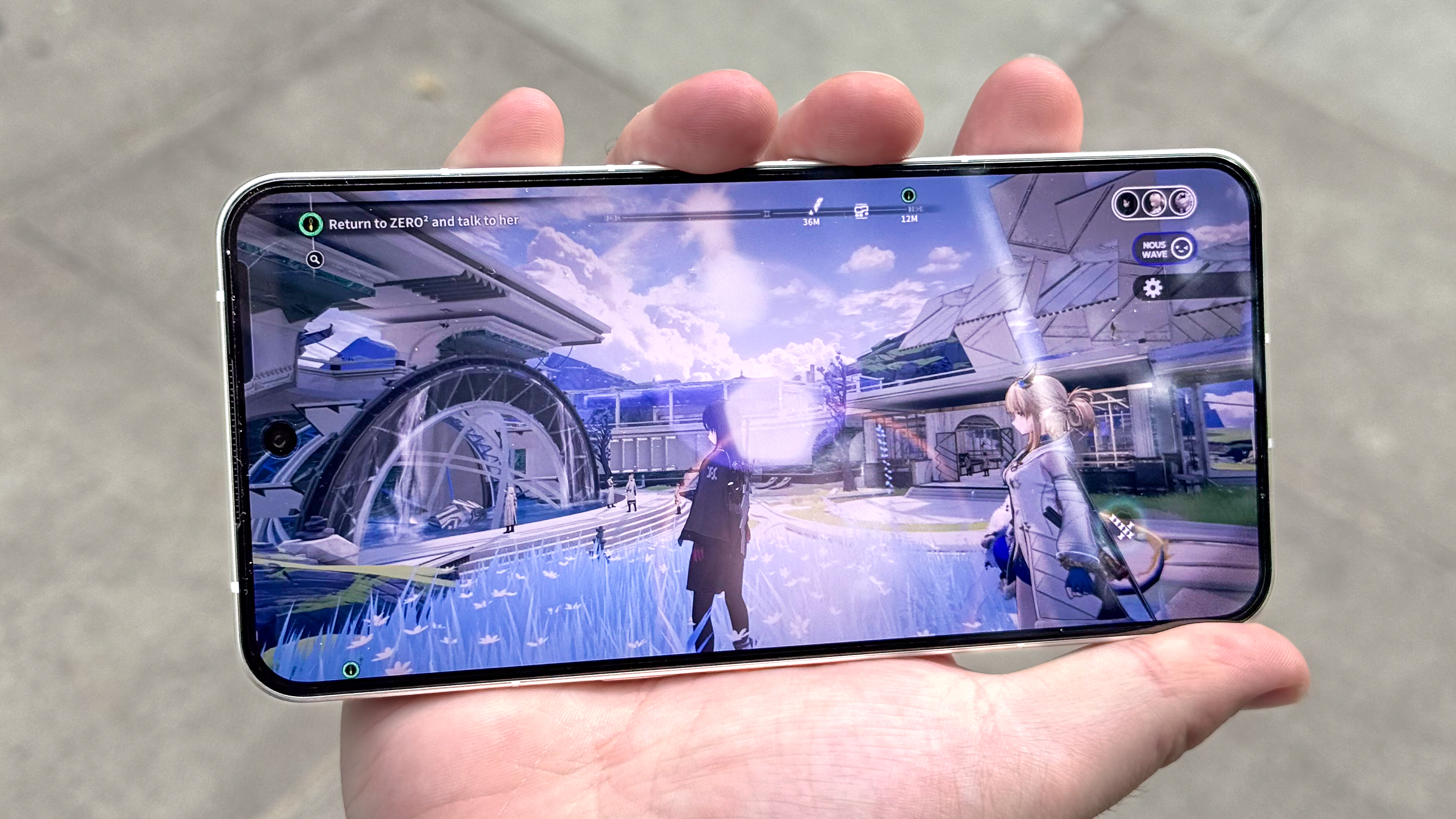
That said, you don't really notice the performance gap. I was able to play Ex Astris at 60fps maximum settings on the Phone 3 without a single framerate drop. While the phone did get uncomfortably hot in the top left corner, it's not where I was gripping the phone during gameplay, so it didn't get in the way of my turn-based battling.
The basic Phone 3 comes with 12GB RAM and 256GB of storage, a good amount for a phone of this price. You can go up to 16GB RAM/512GB storage for just another $100/£100, which is not much extra for double the storage capacity and 33% extra RAM.
Nothing Phone 3: Battery and charging
The 5,150 mAh battery (5,500 mAh for lucky users in India) inside the Phone 3 is a nice step up from the 4,700mAh battery of the Phone 2. It also uses the latest silicon-carbon materials to make the cell more energy dense to reduce the internal space needed for the battery.
In my YouTube-based battery test, the Phone 3 drained 22% of its battery after three hours of continuous playback. The Galaxy S25 Ultra and Pixel 9 Pro XL, both with similar-sized batteries, drained by 15% on the same test, suggesting that Nothing has a way to go in terms of efficiency.
Fortunately the Nothing Phone 3 works with speedy 65W wired and 15W wireless charging. There's 5W reverse wireless and 7.5 reverse wired charging on offer too if you're feeling generous with your battery life. I was able to charge the Phone 3 to 39% in 15 minutes, 68% in 30 and to 100% in 52 minutes using a generic 50W charger. That's pretty snappy, but Nothing promises that the Phone 3 takes just 19 mins to reach 50%, using one of its own chargers.
Nothing Phone 3: Software, AI and special features
In a technical sense, the Nothing Phone 3 runs Android 15 just like its competition. But the design of Nothing OS 3.5 reinforces the Phone 3's uniqueness, with its dot matrix look and monochrome color scheme.
The next-gen OS update — Nothing OS 4.0 by way of Android 16 — is coming in Q3 this year according to the company. This will kick off the Phone 3's promises five years of OS updates and seven years of security updates. That's not quite on par with Samsung and Google's full seven-year pledges, but should still cover the whole time you're likely to be using this phone.
The Glyph Matrix we met earlier is capable of an oddly wide variety of functions via the Glyph Toys widgets. Some are purely practical — a mirror that shows a lo-res version of the view through the main camera and then take selfies, your battery level, the time of day, a secondary flashlight to work with or instead of your camera flash, or a leveler to check if your newly assembled table's properly flat.
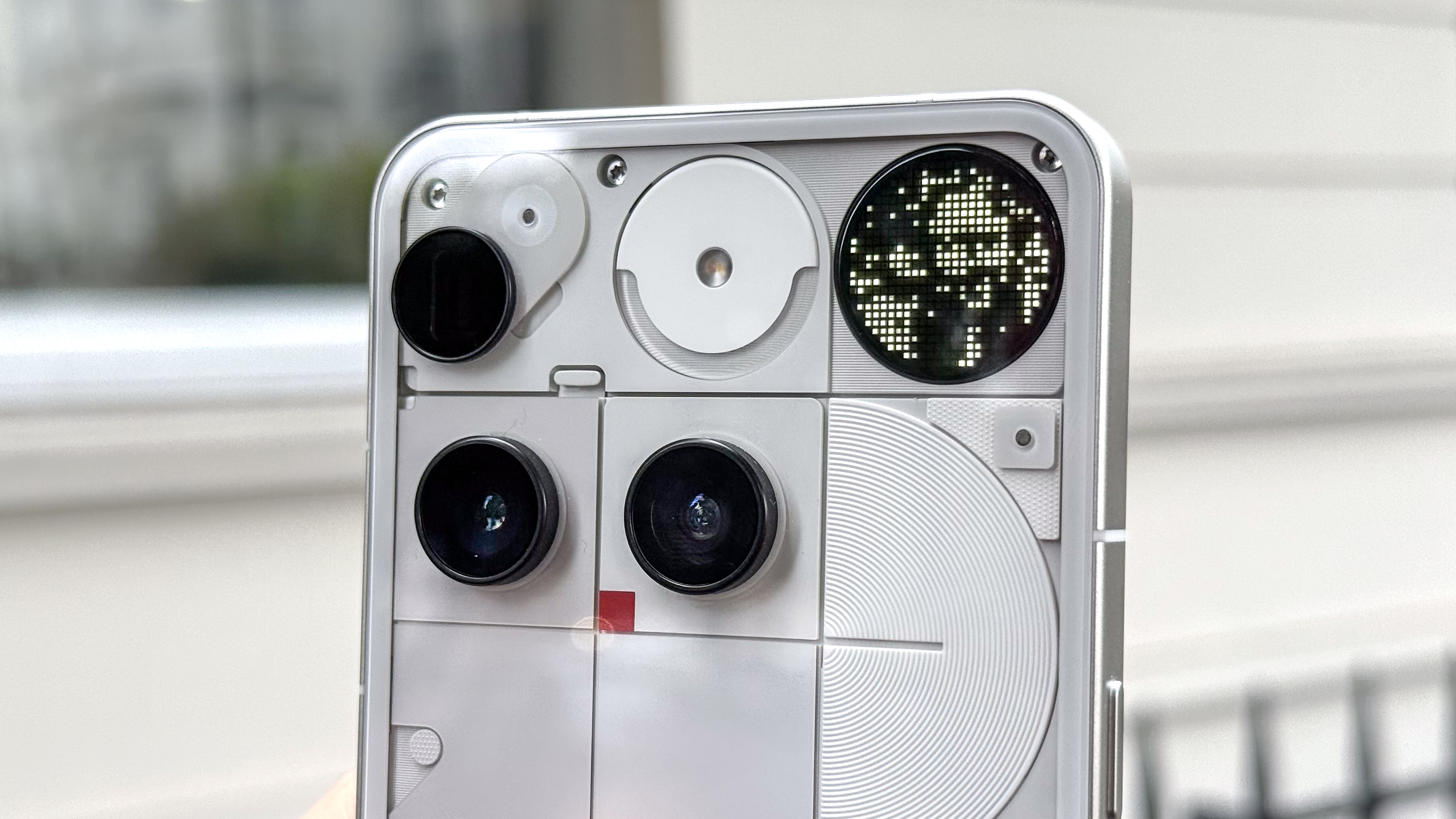
Some are purely for fun, like the Spin the Bottle, Magic 8 Ball or Rock Paper Scissors modes. But I like all of them, except for the stopwatch, which is let down by the control method. Your only input method for the Glyph Matrix with the phone flipped over is the Glyph Button, which lets you swap widgets with a tap and use them with a long press. Given how stopwatches need to be stopped and started quickly to accurately time things, needing to press the button for the best part of a second to trigger the Glyph Toy is not conducive to that.
I'm hopeful Nothing will find a way to sort this out eventually. It's already said it will be adding a Caller ID function to the Glyph Matrix in a July OTA update, plus Nothing has offered up an SDK to developers to add even more features post-launch.
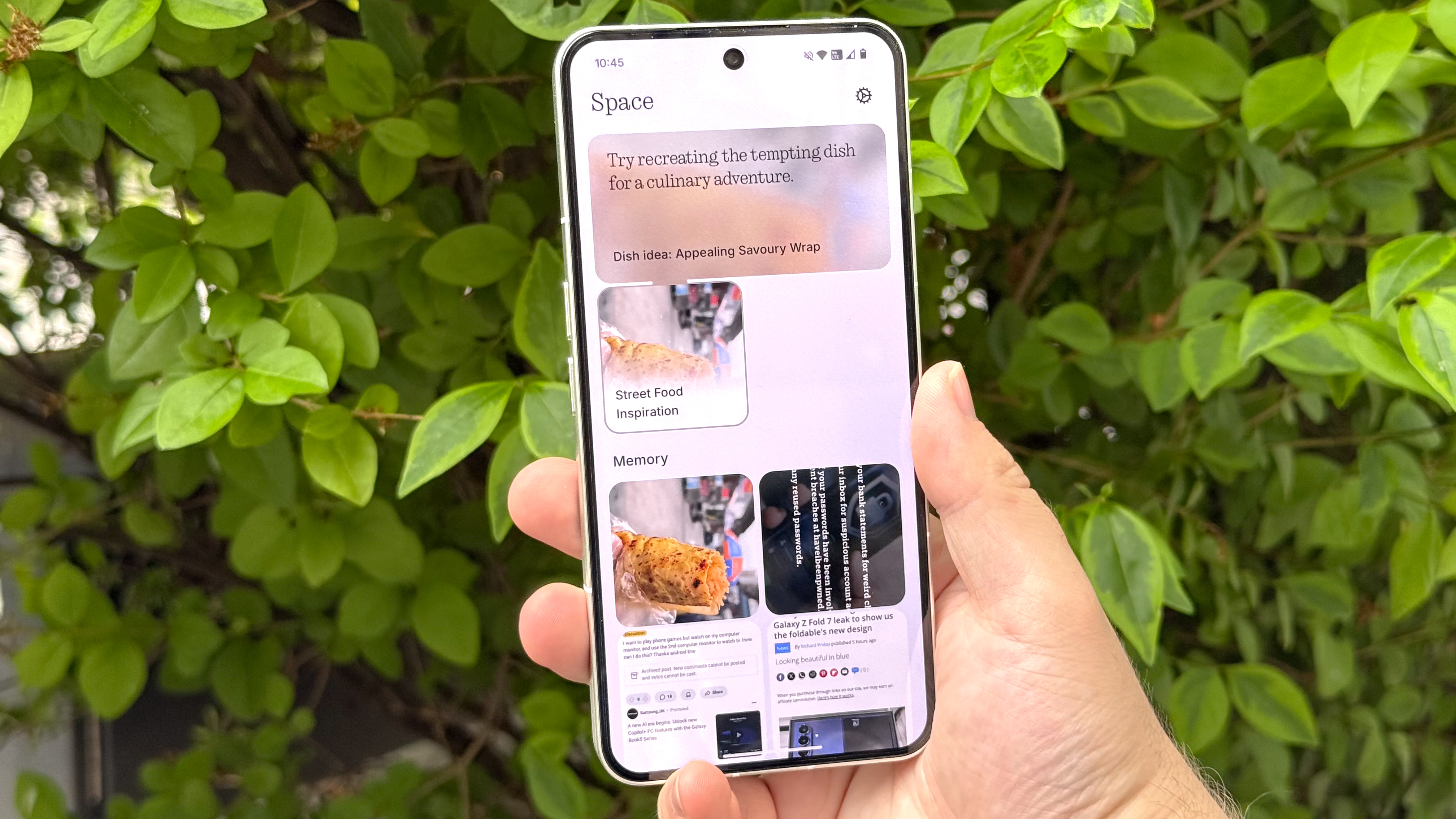
AI isn't a major focus of the Nothing Phone 3's marketing compared to other features, but rest assured it is present. The Essential Space and Essential Key have returned from the Nothing Phone 3a to help you quickly capture screenshots, photos and voice memos and keep and catalog them in an easy-to-access app.
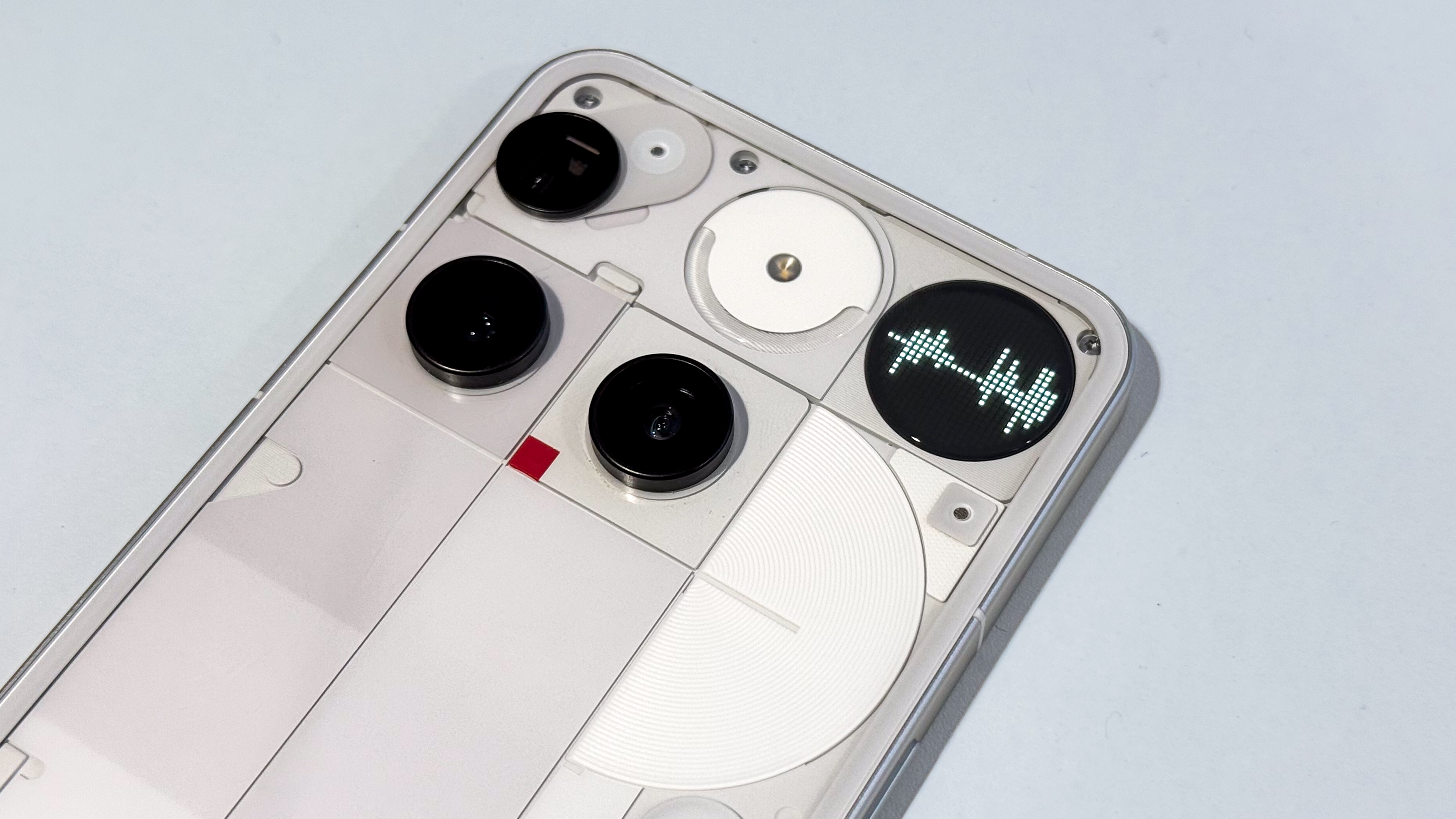
It's also been expanded upon with the Flip to Record feature, which lets you quickly start a recording by holding the Essential Key with the phone facing down, an audio diagram on the Glyph Interface confirming that things are running. You can also tap the button during recording to flag key moments too.
On top of this is Essential Search, which lives in the app drawer. You can use this to hunt for files, contacts, photos and the like, but it can also provide short chatbot-style answers to all kinds of other questions that may be on your mind.
Further personalisation is apparently coming later in the year to Essential Search, which Nothing hints will surface key context around what you're searching for, such as if a contact you've looked up owes you a drink next time you see them, based on messages you've sent each other.
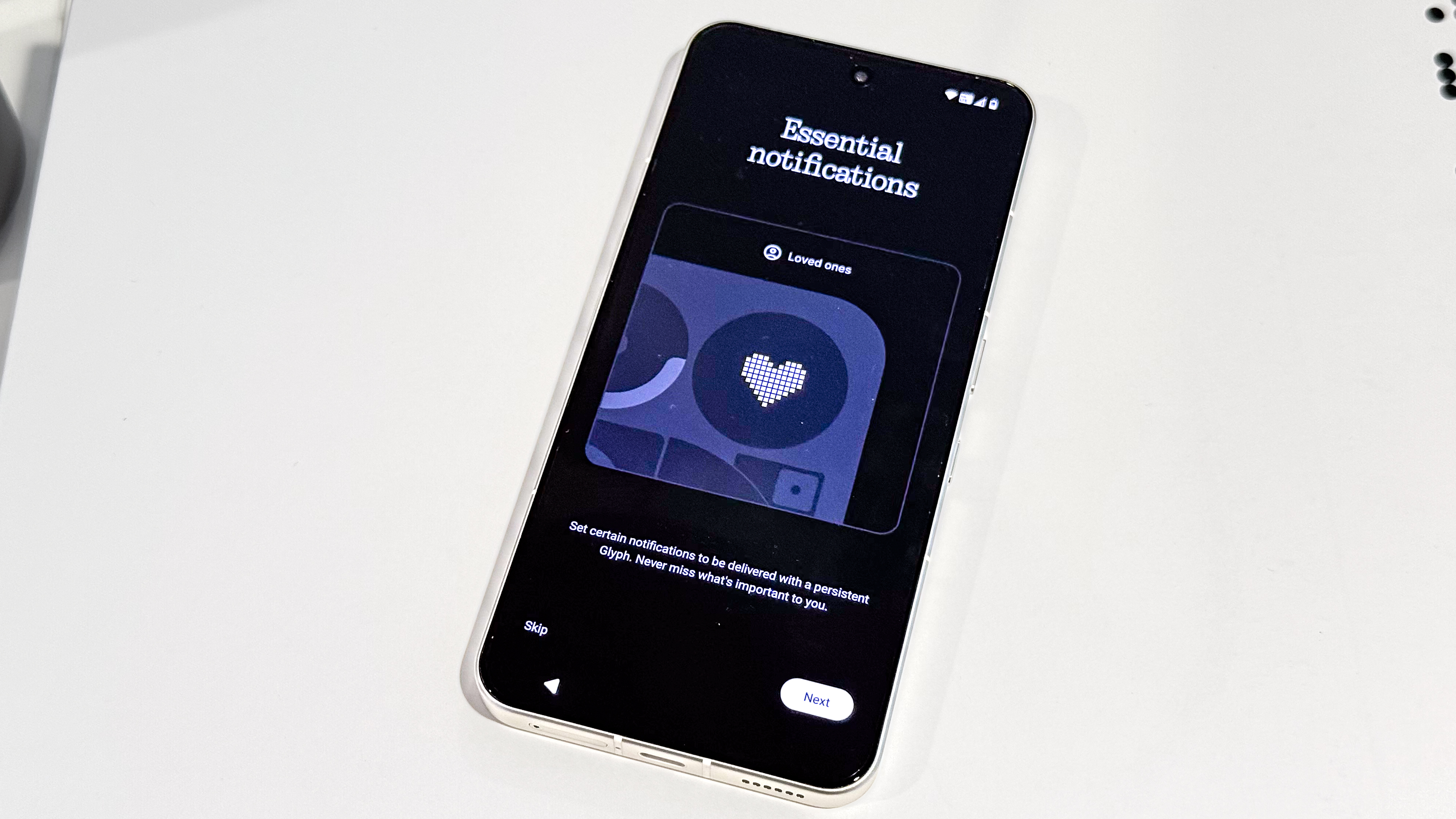
The final feature to look at here is Essential Notifications. This is a notification-filtering system that you can set up based on contacts, apps and keywords, which then pops up glyphs on the back to alert you about what precisely awaits you when you turn the phone over. The Matrix stays lit while notification is unread, to ensure you don't forget, which is something easily distracted people (like myself) can certainly put to good use.
Nothing Phone 3 review: Verdict
The Nothing Phone 3 doesn't intend to be judged on the same terms as other devices. If you do, you will see, as I have in this review, that it has generally strong hardware and excellent software paired with a reasonable price, but it does not outperform the yardstick phones at this price point, like the Galaxy S25 or Pixel 9, overall.
What we have instead is a phone not aimed at the spec-focused or people looking for maximum value, which likely puts a large number of people off immediately. But that's fine — the Galaxy S25, Pixel 9 or one of the best Android phones list will cater to whatever blend of features and pricing you're after. Instead, the Nothing Phone 3 beckons towards phone buyers wanting novelty and personality from their tech, which is something you can't really put a price on.
The price increase compared to last year's Nothing Phone 2 stings, but it has moved the Nothing Phone 3 into a more prominent category in the smartphone market, and has also helped upgrade many of the phone's components. It's now a better balance of practical and aesthetic design, which may not win over a more logical smartphone buyer, but will hopefully convince anyone tempted to join the Nothing crowd that they won't be missing out on too much by doing so.

Richard is based in London, covering news, reviews and how-tos for phones, tablets, gaming, and whatever else people need advice on. Following on from his MA in Magazine Journalism at the University of Sheffield, he's also written for WIRED U.K., The Register and Creative Bloq. When not at work, he's likely thinking about how to brew the perfect cup of specialty coffee.
You must confirm your public display name before commenting
Please logout and then login again, you will then be prompted to enter your display name.
